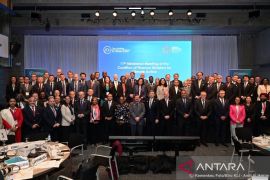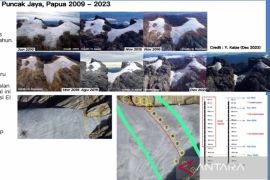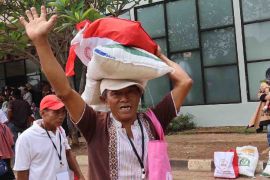This fact is being reflected in how serious the government views the reality. Two presidential instructions are to be issued at the end of this month on measures to safeguard food resilience in Indonesia due to extreme climate change, as Coordinating Economic Minister Hatta Rajasa has said.
"We expect it in January, and in fact we`ve set the target on the third or the fourth week according to the schedule. We`ll mull them with all (the economic ministers) tomorrow," said Minister Rajasa at his office in Jakarta, last Thursday.
Rajasa explained that the aim of the presidential instructions (Inpres) among other is to provide flexibility for the agricultural minister in responding to the extreme climate change that have brought about changes on planting seasons, pest attacks or climate-related destruction of agricultural land.
"Flexibility is certainly needed by the agricultural minister for taking emergency steps as there should be response for that," Minister Rajasa pointed out.
Meanwhile the other Inpres will be for providing flexibility to the state logistics company Bulog in supplying or purchasing the rice produced by farmers, for all varieties of rice, not just some certain varieties, he added.
When the two Inpres have already been issued, according to the minister, then the government will re-formulate the Inpres on anticipating climate change.
"This really is exceptional, the meteorology and geophysics agency has predicted (the seasons) would continue to be wet, something we need to anticipate," he said,
emphasizing the need for a policy response as there would be no alternatives but taking maximum efforts on tackling the impacts from climate change on food production.
The Indonesian government has allocated a contingency fund of 3.0 trillion rupiahs for stabilizing food production in the anticipation of impacts from pest attacks or extreme weather.
Rice Production
As of January 2010, according to Food and Agriculture Organization (FAO), global planting of paddy crops was already well advanced in southern hemisphere countries. In South America, however, the season opened negatively due to drought or excessive rainfall that has delayed sowing of the main crops.
It is also feared that drought related to El Nino may decrease rice production in Indonesia, the UN agricultural body emphasizes in a recent statement.
There has been a major decline in world rice production since late 2007 due to many reasons including climatic conditions in many top rice producing countries as well as policy decision regarding rice export by the governments of countries with considerable rice production.
Reason for low world rice production in 2009 global rice price started increasing in November 2009 after months of steadily declining since reaching an all time high in May 2008. Problems related to price supply in two major rice producing countries - India and the Philippines - have been the primary reason for low world production of rice and the reversal of price trend.
Indonesia was at the third place after China and India as the world top producers of rice. China in 2010 produced 166.4 million tons of rice, India produced 132 million tons, and Indonesia produced 52 million tons. However, these three countries are also the world`s largest by population.
Upside down
Climate change has changed precipitation patterns in Indonesia upside down, according to a result of a recent study by World Wide Fund for Nature (WWF), titled "Climate Change in Indonesia, Implication for Humans and Nature."
Precipitation patterns have changed as there has been a decline in annual rainfall in the southern regions of Indonesia and an increase in precipitation in the northern regions. The seasonality of precipitation (wet and dry seasons) has changed were wet season rainfall in the southern region has increased while dry season rainfall in the northern region has decreased.
The climate is warming from 0.2 to 0.3 centigrade per decade in Indonesia, resulting in the increase in annual precipitation across the majority of the Indonesian islands, except in southern Indonesia where is it projected to decline by up to 15 percent.
The seasonality of precipitation has also changed where parts of Sumatra and Sulawesi may become 10 to 30 percent wetter by the 2080`s during December-February, the months known as wet seasons for Indonesia.
There has also been a shift in the seasonality of precipitation (wet and dry seasons); in the southern region of Indonesia the wet season rainfall has increased while the dry season rainfall has decreased, whereas the opposite pattern was observed in the northern region of Indonesia, it notes.
Increased frequency and severity of El Nino events and fires will impact food production and the ability of natural systems to provide ecosystem services, whereas arming ocean temperatures, sea-level rise, and increased storms will impact coastal systems by increasing coral bleaching events, changes in fish availability, inundation of coast lines and mangroves.
The El Nino-induced droughts of 1997-1998 caused massive crop failures, water storage, and forest fires in parts of Indonesia and if climate model projections of stronger, more frequent El Nino events materialize, Indonesia may experience even more adverse impacts, including less food production and increased hunger.
The study concludes that the challenge for Indonesia is to create appropriate and effective adaptation strategies to address climate change and its impacts by building resilience and resistance. Action needs to take place at all levels; from international, to national, local and community-based efforts.(*)
Reporter: Vicki Febrianto
Editor: Aditia Maruli Radja
Copyright © ANTARA 2011










